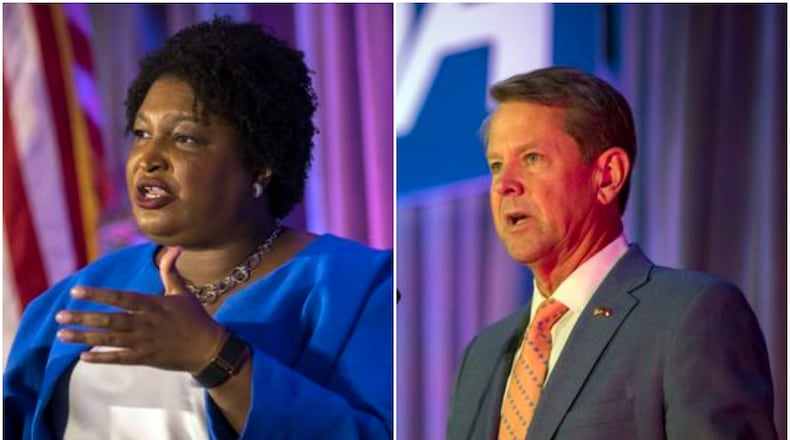When Democratic megadonor George Soros put $2.5 million into Stacey Abrams’ race for governor earlier this year, it showed how the Republican-created leadership committee law opened the door for big money contributors to put almost limitless money into a few Georgia contests.
His contribution may be closer to the norm in coming months.
In all, leadership committees for Abrams, Gov. Brian Kemp, Republican lieutenant governor nominee Burt Jones and Georgia House and Senate leaders had raised a combined $27 million by June 30, mostly in the months leading up to the disclosure filing deadline.
Both sides expect a windfall as the general election nears, a period when major out-of-state political action committees and donors will be giving millions in hopes that their side wins in November.
“I would say for both the governor and Stacey there is not a more efficient fundraising ally than the leadership committee, and they will be the recipients of big contributions,” said John Watson, former chairman of the Georgia Republican Party.
The newly created committees — approved by the Republican-led General Assembly over opposition from Democrats — are “efficient” because they allow a few politicians like Kemp and Abrams to raise unlimited contributions from donors like Soros or megadonors on the Republican side, skirting limits placed on most candidates.
Statewide candidates, such as those running for governor, are currently allowed to raise $7,600 from individual donors for the primary and again for the general election.
Over just a few months this spring, Abrams’ One Georgia leadership committee received a $1.5 million donation from Fair Fight, the voting rights group she founded; $1 million from the Democratic governors’ association; and $2.5 million from Silicon Valley philanthropist and major Democratic donor Karla Jurvetson.
She received $1 million each from the International Brotherhood of Electrical Workers; the American Federation of State, County and Municipal Employees; Elizabeth Simons, co-founder of the Heising-Simons Foundation; and Donald Sussman, an asset manager and philanthropist.
Kemp’s Georgians First leadership committee got $100,000 from Michigan GOP donor Jon Cotton, CEO of ApexHealth, a provider of Medicare Advantage plans; Georgians Donald Leebern III and Ben Tarbutton, whose families have traditionally been big donors to governors in power; and Lucky Bucks, a coin-operated machine company.
He also received several big contributions from business groups that have lobbyists at the Capitol.
The size of the donations to Kemp’s committee are expected to get a lot bigger as the general election nears and national Republican groups start plowing more money into his race for reelection.
The Abrams camp expects as much.
“Brian Kemp is here to cash in with his leadership committee and we expect him to rake in money from those who want to protect his incumbency and protect their interests,” said Lauren Groh-Wargo, who is Abrams’ campaign manager.
Kemp campaign spokesman Tate Mitchell said, “Georgians First Leadership Committee is laser-focused on sharing Gov. Kemp’s record of putting Georgians first and making sure George Soros and other liberal elites from New York and California don’t buy this governor’s race for Stacey Abrams and her radical agenda.”
Changing the law
Republican lawmakers pushed for the new special fundraising tools during the 2021 session in part because they knew Abrams can raise money nationally. Legislative leaders — who have at times been at odds with the state Republican Party leadership — also wanted more control of the big money flowing in from donors.
Credit: Alyssa Pointer
Credit: Alyssa Pointer
When she ran for governor in 2018, Abrams spent a record $27 million, outraising Kemp despite the fact that Georgia had been a reliably Republican state in major races since the early 2000s. In that election, Kemp won a narrow victory anyway.
After the election that year, the voting rights group Abrams founded, Fair Fight, created a national fundraising machine of its own, taking in more than $100 million by last year and helping to fuel Democratic Party efforts in states across the country during the 2020 elections, including in Georgia. Abrams and the organization were credited with helping Democrats win Georgia for Joe Biden in the presidential race and flip two U.S. Senate seats.
Republican leaders responded by passing legislation to let the governor, the opposing party’s gubernatorial nominee, the lieutenant governor nominees and party caucuses create special leadership committees to raise as much cash as they can, without limits for individual donors.
Democrats opposed the measure, saying it would set special rules for a few top politicians and allow lobbyists and special interests to hand unlimited checks to state officials during legislative sessions. Rank-and-file lawmakers are barred by law from raising money during the session.
It gave Kemp an added edge since challengers couldn’t create the funds until they won their party’s nomination in May. The governor’s campaign, meanwhile, was the first to create a committee and began raising money last summer, right after the bill became law.
The law also allows leadership committees to coordinate their activities with a candidate’s campaign, something other fundraising entities such as PACs aren’t allowed to do under Georgia law. It essentially allows select candidates to circumvent fundraising caps that apply to most people running for office.
As of June 30, the law had helped Abrams’ campaign more than Kemp’s: Of the $27 million raised by leadership committees as of that date, $18.5 million had been taken in by the Democrat’s One Georgia fund.
Watson said Abrams’ supporters across the nation would find a way to pour big money into her campaign with or without the leadership committee law. But Kemp and Republicans won’t be starving for millions in the final few months of the campaign.
“Do I think there is going to be tons of money on both sides? Without a doubt,” said Rick Thompson, a member of the state ethics commission who runs a campaign disclosure reporting business. “I would be surprised if there weren’t a lot of money coming into these leadership committees this fall.”
But he also questioned the ultimate value of unlimited spending by the major campaigns.
“The money in Georgia will increase because we have this (fundraising) avenue,” Thompson said. “But you can only put so much money into an election until it doesn’t matter anymore. You can only buy so much airtime. You could put $1 billion into a race, but the market would be oversaturated and it may not make a difference in the outcome.”
Leadership committee fundraising
Totals run through June 30:
One Georgia (Stacey Abrams) — $18,513,433
Georgians First (Gov. Brian Kemp) — $7,632,308
Advancing Conservative Values (House Republicans) — $631,000
Citizens for a Greater Georgia (Senate Republicans) — $442,188
Georgia Blue PAC (House Democrats) — $294,000
Georgia Senate Majority Defense Fund (Senate Democrats) — $229,971
WBJ Leadership Committee (Burt Jones, Republican lieutenant governor nominee) — $60,000
A Strong Georgia (House Majority Leader Jon Burns) — $1,000
Source: state ethics commission filings
About the Author
Keep Reading
The Latest
Featured



